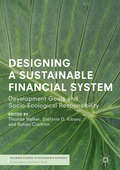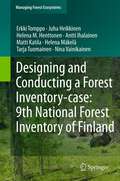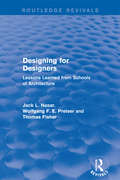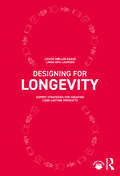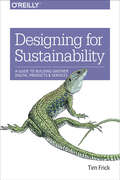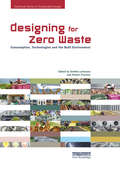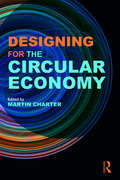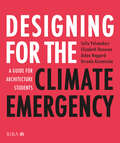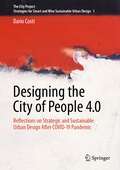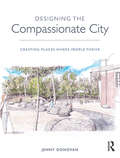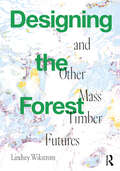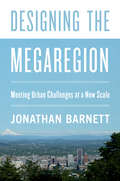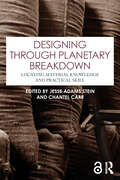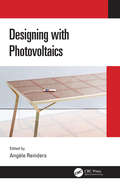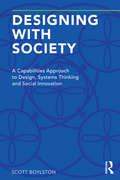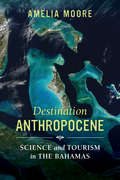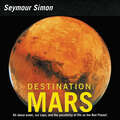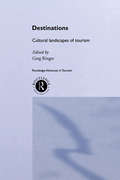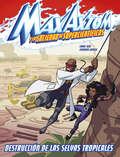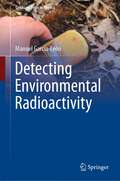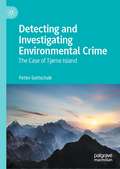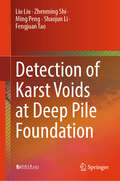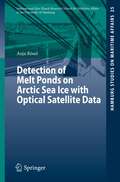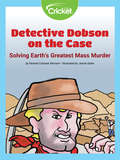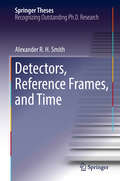- Table View
- List View
Designing a Sustainable Financial System: Development Goals and Socio-Ecological Responsibility (Palgrave Studies in Sustainable Business In Association with Future Earth)
by Thomas Walker Stéfanie D. Kibsey Rohan CrichtonThis edited collection brings together leading theoretical and applied research with the intent to design a sustainable global financial future. The contributors argue that our world cannot move toward sustainability, address climate change, reverse environmental degradation, and improve human well-being without aligning the financial system with sustainable development goals like those outlined by the United Nations. Such a system would: a) be environmentally and socially responsible; b) align with planetary boundaries; c) manage natural resources sustainably; d) avoid doing more harm than good; and e) be resilient and adaptable to changing conditions. The overarching theme in this collection of chapters is a response to the worldwide, supranational sustainable finance discussions about how we can transition to a new socio-ecological system where finance, human well-being, and planetary health are recognized as being highly intertwined.
Designing and Conducting a Forest Inventory - case: 9th National Forest Inventory of Finland
by Matti Katila Juha Heikkinen Helena M. Henttonen Tarja Tuomainen Nina Vainikainen Antti Ihalainen Helena Mäkelä Erkki TomppoThis book demonstrates in detail all phases of the 9th National Forest Inventory of Finland (1996-2003): the planning of the sampling design, measurements, estimation methods and results. The inventory knowledge accumulated during almost one hundred years is consolidated in the book. The purpose of the numerous examples of results is to demonstrate the diversity of the estimates and content of a national forest inventory. The most recent results include the assessment of the indicators describing the biodiversity of forests. The Finnish NFI has been and is a model for many countries worldwide. The methods and results of the book are set in the international context and are applicable globally. The book provides a valuable information source for countries, institutions and researchers planning own inventories as well as modifying the existing ones, or seeking the applicable definitions and estimation methods to use in their own inventories.
Designing for Designers: Lessons Learned from Schools of Architecture (Routledge Revivals)
by Thomas Fisher Wolfgang F. Preiser Jack NasarFirst published in 2007, this book examines the designs of seventeen architecture and design schools and answers questions such as: How has architectural education evolved and what is its future? Are architectural schools discernible types of designs and what are their effects on those who experience them? What lessons can be learned from evaluations of recently completed school buildings and what guidance do they provide for the design of future ones? Included in the multiple approaches to evaluation are examinations of the history of architectural education and building form; typologies of school for architecture; and the systematic user evaluations of the aesthetics, function, and technology which reveal the strengths to encourage and weaknesses to avoid in future designs. While offering specific guidelines for schools of design, it also includes findings that extend beyond the walls of design schools and can be applied to everything from the interiors of educational and campus buildings to planning offices and gathering places to build communities. This book will make readers more aware of problems in architectural interiors and suggest ways to make interiors work better for the building occupants.
Designing for Longevity: Expert Strategies for Creating Long-Lasting Products
by Louise Møller Haase Linda Nhu LaursenProduct longevity is one of the cornerstones in the transition towards a more sustainable society and a key driver for the circular economy model. This book provides designers, developers, and creators with five distinctive expert strategies, detailed case studies, action guides and worksheets that support both beginning and advanced design practitioners in creating new product concepts with long-lasting strategic fits. Designing for Longevity shows how expert design teams create original and long-lasting product concepts from the early development phase. It focuses on integrating business knowledge, market conditions, company capabilities, technical possibilities and user needs into product concepts to make better strategic decisions. It demonstrates how, for products to be durable, designers must create a long-lasting strategic fit for the customer, company, and market. Key case studies of products such as Bang & Olufsen’s A9, LEGO Ninjago and Friends and Coloplasts’ Sensura Mio, among others, offer readers inspiration, guidance and real-world insights from design teams showing how the strategies can be applied in practice. Action guidelines and worksheets encourage broad, analytical problem-solving to identify and think through challenges at the early concept stage. Beautifully designed and illustrated in full colour throughout, this book combines original research and the hands-on tools and strategies that design practitioners need to create useful, sustainable products.
Designing for Sustainability: A Guide to Building Greener Digital Products and Services
by Tim FrickPixels use electricity, and a lot of it. If the Internet were a country, it would be the sixth largest in terms of electricity use. That’s because today’s average web page has surpassed two megabytes in size, leading to slow load times, frustrated users, and a lot of wasted energy. With this practical guide, your web design team will learn how to apply sustainability principles for creating speedy, user-friendly, and energy-efficient digital products and services.Author Tim Frick introduces a web design framework that focuses on four key areas where these principles can make a difference: content strategy, performance optimization, design and user experience, and green hosting. You’ll discover how to provide users with a streamlined experience, while reducing the environmental impact of your products and services.Learn why 90% of the data that ever existed was created in the last yearUse sustainability principles to innovate, reduce waste, and function more efficientlyExplore green hosting, sustainable business practices, and lean/agile workflowsPut the right things in front of users at precisely the moment they need them—and nothing moreIncrease site search engine visibility, streamline user experience, and make streaming video more efficientUse Action Items to explore concepts outlined in each chapter
Designing for Zero Waste: Consumption, Technologies and the Built Environment
by Steffen Lehmann Robert CrockerDesigning for Zero Waste is a timely, topical and necessary publication. Materials and resources are being depleted at an accelerating speed and rising consumption trends across the globe have placed material efficiency, waste reduction and recycling at the centre of many government policy agendas, giving them an unprecedented urgency. While there has been a considerable literature addressing consumption and waste reduction from different disciplinary perspectives, the complex nature of the problem requires an increasing degree of interdisciplinarity. Resource recovery and the optimisation of material flow can only be achieved alongside and through behaviour change to reduce the creation of material waste and wasteful consumption. This book aims to develop a more robust understanding of the links between lifestyle, consumption, technologies and urban development.
Designing for the Circular Economy
by Martin CharterThe circular economy describes a world in which reuse through repair, reconditioning and refurbishment is the prevailing social and economic model. The business opportunities are huge but developing product and service offerings and achieving competitive advantage means rethinking your business model from early creativity and design processes, through marketing and communication to pricing and supply. Designing for the Circular Economy highlights and explores ‘state of the art’ research and industrial practice, highlighting CE as a source of: new business opportunities; radical business change; disruptive innovation; social change; and new consumer attitudes. The thirty-four chapters provide a comprehensive overview of issues related to product circularity from policy through to design and development. Chapters are designed to be easy to digest and include numerous examples. An important feature of the book is the case studies section that covers a diverse range of topics related to CE, business models and design and development in sectors ranging from construction to retail, clothing, technology and manufacturing. Designing for the Circular Economy will inform and educate any companies seeking to move their business models towards these emerging models of sustainability; organizations already working in the circular economy can benchmark their current activities and draw inspiration from new applications and an understanding of the changing social and political context. This book will appeal to both academia and business with an interest in CE issues related to products, innovation and new business models.
Designing for the Climate Emergency: A Guide for Architecture Students
by Sofie Pelsmakers Aidan Hoggard Urszula Kozminska Elizabeth DonovanWe are in a climate emergency. Architects must be part of the radical change needed. This book guides architecture student to create truly sustainable designs. Demonstrating holistic design approaches through 10 key themes, it guides students through the different stages of the design process in five illustrated chapters. Reflecting the years of study, it provides step-changes towards eventual architecture practice. Unique features include key checklists, case studies, student examples and an extensive glossary.
Designing the City of People 4.0: Reflections on strategic and sustainable urban design after Covid-19 pandemic (The City Project #1)
by Dario CostiThis book collects a set of reflections concerning the planning of contemporary cities by urban design, with a special emphasis on some needs and shortcomings emerged during the coronavirus pandemic. With the ultimate goal of designing accessible, inclusive and welcoming green cities, it discusses the urgent need for new systems of public spaces across the city, together with alternative solutions for individual mobility (especially slow mobility) and social interaction. It is intended for a broad readership, including designers, engineers, architects, social scientists, stakeholders, and public administrators, who deal with various aspects of the realization of the City 4.0.
Designing the Compassionate City: Creating Places Where People Thrive
by Jenny DonovanDesigning the Compassionate City outlines an approach to urban design that is centred on an explicit recognition of the inherent dignity of all people. It suggests that whether we thrive or decline—as individuals or as a community—is dependent on our ability to fulfil the full spectrum of our needs. This book considers how our surroundings help or hinder us from meeting these needs by influencing both what we can do and what we want to do; either inspiring us to lead healthy, fulfilled lives or consigning us to diminished lives tainted by ill health and unfulfilled potential. Designing the Compassionate City looks at how those who participate in designing towns and cities can collaborate with those who live in them to create places that help people to accumulate the life lessons, experiences and achievements, as well as forge the connections to meet their needs, to thrive and to fulfil their potential. The book explores a number of inspiring case studies that have sought to meet this challenge and examines what has worked and what hasn’t. From this, some conclusions are drawn about how we can all participate in creating places that leave a lasting legacy of empowerment and commitment to nurturing one another. It is essential reading for students and practitioners designing happier, healthier places.
Designing the Forest and other Mass Timber Futures
by Lindsey WikstromIf we want to continue existing on this earth, an era of renewable energy and materials is urgently needed. What role could mass timber, with its potential to replace concrete and steel, have in ensuring the planet’s survival? This book retraces wood’s passage from stewarded seed in the soil of forests, to harvested biomass, to laminated walls in a living room, through to its disassembly, pausing at each step in the supply chain of mass timber to consider the labor and economies involved, looking closely at the way wood is grown, sourced, and transported, and its impacts on the biodiversity of the forest and the health of our ecosystems. It explores why historically entrenched contexts of extractivism make such sensitive approaches difficult to cultivate across landscapes and industrial frameworks. Along the way, common assumptions about mass timber are debunked, including its fire performance, its strength, and its role in carbon sequestration. Having identified contemporary technical, cultural, and spiritual gaps preventing the transition towards a fully timber built environment, it outlines how we might move forward. A more sensitive species-based methodology is essential, with designers as choreographers of carbon, transferring and trading between forest, factory, site, and beyond. This will be an important read for anyone interested in our built environment and how to design it to be non-extractive, especially those with an interest in architecture, urbanism, forests, ecology, and timber, as well as students of architecture and design interested in the generative nature of materials and design processes.
Designing the Megaregion: Meeting Urban Challenges at a New Scale
by Jonathan BarnettAs the US population grows—potentially adding more than 110 million people by 2050—cities and their suburbs will continue expanding, eventually meeting the suburbs of neighboring cities and forming continuous urban megaregions. There are now at least a dozen megaregions in the US, such as the one extending from Richmond, Virginia, to Portland, Maine, and the megaregion that runs from Santa Barbara through Los Angeles and San Diego, down to the Mexican border. In Designing the Megaregion, planning and urban design expert Jonathan Barnett takes a fresh look at designing megaregions. Barnett argues that planning megaregions requires ecological literacy and a renewed commitment to social equity in order to address the increasing pressure this growth puts on natural, built, and human resources. If current trends continue, new construction in megaregions will put additional stress on natural resources, make highway gridlock and airline delays much worse, and cause each region to become more separate and unequal. Barnett offers an incremental approach to designing at the megaregional scale that will help prepare for future economic and population growth. Designing the Megaregion explains how we can, and should, redesign megaregional growth using mostly private investment, without having to wait for large-scale, government initiatives and trying to create whole new governmental structures. Barnett explains practical initiatives for adapting development in response to a changing climate, improving transportation systems, and redirecting the forces that make megaregions very unequal places. There is an urgent need to begin designing megaregions, and Barnett offers a hopeful way forward using systems that are already in place.
Designing through Planetary Breakdown: Locating Material Knowledge and Practical Skill
by Jesse Adams Stein Chantel CarrIn an era of profound environmental and geopolitical uncertainty, Designing through Planetary Breakdown offers fresh perspectives on design’s evolving role in the face of planetary change. This unique collection emphasises practices and perspectives at the edges of conventional design, encompassing craft, material knowledge, repair, manual skills, creative practice and non-professional design, to reveal how design can address urgent challenges in grounded, hands-on ways.Structured into two sections – Skills and Capacities, and Care and Generative Practices – the chapters cover a rich range of topics examining both traditional and emerging approaches to making, caring and maintaining. Readers will find reflections on community-led adaptive urban heat strategies in Western Sydney, First Nations’ perspectives on design labour, repair-led design education initiatives, and the ethical and social dimensions of global supply chains. The book journeys through a wide range of empirical examples, including from Cuba, Indonesia, Spain and Australia, offering insights into generative transformations of materials and technologies. It demonstrates how design, expanded beyond the traditional professional confines, can foster practical responses to global issues.Designing through Planetary Breakdown is ideal for scholars, students, designers and craftspeople across design studies, design anthropology, repair and discard studies, craft studies and more broadly in the humanities and social sciences. Practical and deeply social, this collection offers a call to action: a guide for all hands to shape a future not just of survival, but of regeneration and collective action. The Introduction and Chapter 3 of this book is freely available as a downloadable Open Access PDF at http://www.taylorfrancis.com under a Creative Commons [Attribution-Non Commercial-No Derivatives (CC BY-NC-ND)] 4.0 license.
Designing with Photovoltaics
by Angèle Reinders"Designing with Photovoltaics" cover a broad range of topics related to the design of products, buildings and vehicles with integrated photovoltaic (PV) technologies including storage aspect. It enables the reader to easily design new products, buildings and vehicles through use of innovative PV products. Diverse categories of product integrated PVs are discussed including applications of solar power for mobility and building integrated systems along with design- and manufacturing-related information about solar cells. Illustrating design cases of various PV-powered products, special attention is paid to end-users and environmental aspects of PV applications. Aimed at senior undergraduates, graduates and professionals in electrical engineering, architecture, design, physics, mechanical engineering and those specifically studying photovoltaics, it Covers the different product integrated photovoltaics (PIPV) with a focus on design and manufacturing Presents comprehensive overview of all aspects of designing with photovoltaics Includes product integrated PV, building integrated PV and solar powered mobility concepts Contains real design cases showing how to design with photovoltaics Discusses context of environmental issues and user aspects
Designing with Society: A Capabilities Approach to Design, Systems Thinking and Social Innovation
by Scott BoylstonThis book explores an emerging design culture that rigorously applies systems thinking to the practice of design as a form of facilitating change on an increasingly crowded planet. Designers conversant in topics such as living systems, cultural competence, social justice, and power asymmetries can contribute their creative skills to the world of social innovation to help address the complex social challenges of the 21st century. By establishing a foundation built on the capabilities approach to human development, designers have an opportunity to transcend previous disciplinary constraints, and redefine our understanding of design agency. With an emphasis on developing an adaptability to dynamic situations, the cultivation of diversity, and an insistence on human dignity, this book weaves together theories and practices from diverse fields of thought and action to provide designers with a concrete yet flexible set of actionable design principles. And, with the aim of equipping designers with the ability to drive long-term, sustainable change, it proposes a new set of design competences that emphasize a deeper mindfulness of our interdependence; with each other, and with our life-giving natural systems. It’s a call to action to use design and design thinking as a tool to transform our collective worldviews toward an appreciation for what we all hold in common; a hope and a belief that our future is a place where all of humankind will flourish.
Destination Anthropocene: Science and Tourism in The Bahamas (Critical Environments: Nature, Science, and Politics #7)
by Amelia MooreDestination Anthropocene documents the emergence of new travel imaginaries forged at the intersection of the natural sciences and the tourism industry in a Caribbean archipelago. Known to travelers as a paradise of sun, sand, and sea, The Bahamas is rebranding itself in response to the rising threat of global environmental change, including climate change. In her imaginative new book, Amelia Moore explores an experimental form of tourism developed in the name of sustainability, one that is slowly changing the way both tourists and Bahamians come to know themselves and relate to island worlds.
Destination: Revised Edition
by Seymour SimonAward-winning science writer Seymour Simon explores the Red Planet through fascinating facts and amazing full-color photographs. Readers will learn about the recent discovery of water, the Valles Marineris—the biggest valley on Mars—the ice caps, recent expeditions, and more. This nonfiction picture book is an excellent choice to share during homeschooling, in particular for children ages 6 to 8. It’s a fun way to learn to read and as a supplement for activity books for children.This updated edition includes:author’s notestunning full-color photographsglossaryindexwebsites and additional reading sourcesSupports the Common Core Learning Standards, Next Generation Science Standards and the Science, Technology, Engineering, and Math (STEM) standards.
Destinations: Cultural Landscapes of Tourism (Routledge Advances in Tourism)
by Greg RingerThis book presents new directions both for tourism and cultural landscape studies in geography, crossing the traditional boundaries between the research of geographers and scholars of the tourism industry.Drawing on selected research from Europe, Southeast Asia, the Pacific and North America, the contributors combine perspectives in human geography and tourism to present cultural landscapes of tourist destinations as socially constructed places, examining the extent and manner by which tourism both establishes and falsifies local reality.The book addresses many critical themes which recent critiques in tourism studies focusing on the attitudes and behaviour of the tourist and on the industry as agents of social change have ignored, including the marginalization of the 'host' community, the privatization and commodification of local culture, and how tourism acts as both agent and process in the structure, identity and meaning of local places.
Destrucción de las selvas tropicales: una aventura de Max Axiom, supercientífico (Max Axiom y la sociedad de supercientíficos)
by Carol KimEn todo el mundo se talan árboles. Pero ¿por qué se talan los bosques lluviosos, y qué ocurrirá si se desaparecen? En esta novela gráfica de no ficción, Max Axiom y la Sociedad de supercientíficos tienen la misión de averiguarlo. Utilizando sus superpoderes y su superinteligencia, el equipo desglosará cada pieza de este complejo problema medioambiental en una aventura emocionante e informativas para que los jóvenes lectores puedan conocer las causas y los efectos de la deforestación y descubrir las medidas que todos podemos tomar para proteger estos frágiles ecosistemas.
Detecting Environmental Radioactivity (Graduate Texts in Physics)
by Manuel García-LeónThis textbook presents the principles and methods for the measurement of radioactivity in the environment. In this regard, specific low-level radiation counting and spectrometry or mass spectrometry techniques are discussed, including sources, distribution, levels and dynamics of radioactivity in nature. The author gives an accurate description of the fundamental concepts and laws of radioactivity as well as the different types of detectors and mass spectrometers needed for detection. Special attention is paid to scintillators, semiconductor detectors, and gas ionization detectors. In order to explain radiochemistry, some concepts about chemical separations are introduced as well. The book is meant for graduate and advanced undergraduate students in physics, chemistry or engineering oriented to environmental sciences, and to other disciplines where monitoring of the environment and its management is of great interest.
Detecting and Investigating Environmental Crime: The Case of Tjøme Island
by Petter GottschalkThis book discusses environmental crime and individual wrongdoing. It uses the theory of convenience throughout to examine financial motives, attractive opportunities, and personal willingness to explain deviant behavior. This book focusses primarily on the case study of the Island of Tjøme in Norway, an attractive resort where building permits were repeatedly granted to rich people in a protected zone along the shoreline. This book investigates how these crimes were detected and investigated by police over a few years with the help of whistleblowers. It discusses the interplay between the potentially corrupt public officials, professionals like architects and attorneys, and rich individuals, as an interesting and challenging arena for law enforcement. It covers attorneys’ defense strategies, evaluates private internal policing, and provides insights for those investigating individuals involved in environmental crime. It also examines the Vest Tank toxic waste dumping case and the resulting explosion where unusually both the chairperson and the chief executive were successfully sentenced to prison because of environmental crime, unlike many other environmental crime cases where individuals avoid prison. The case studies are drawn from Norway to supplement more well-known case studies from the USA.
Detection of Karst Voids at Deep Pile Foundation
by Zhenming Shi Ming Peng Liu Liu Shaojun Li Fengjuan TaoKarst voids at pile locations can have a significant negative impact on the bearing capacity and overall safety of cast-in-place pile foundations. This book introduces a state-of-the-art detection system, comprising of specialized equipment, algorithms, and software, designed to identify karst voids during deep cast-in-place pile foundation construction. The system includes a unique multifrequency borehole sonic probe, a single borehole radar, two pile hole sonar probes, and a corresponding signal analysis method. Several field and synthetic tests have been conducted to detect karst voids during cast-in-place pile foundation construction, and the results demonstrate that this technology can offer detailed geological information for pile design and ensure the safety of foundation construction. The work presented in this book has received the First Prize for Technological Invention in Shanghai, China in 2022.
Detection of Melt Ponds on Arctic Sea Ice with Optical Satellite Data
by Anja RöselThe Arctic sea ice is characterized by profound changes caused by surface melting processes and the formation of melt ponds in summer. Melt ponds contribute to the ice-albedo feedback as they reduce the surface albedo of sea ice, and hence accelerate the decay of Arctic sea ice. To quantify the melting of the entire Arctic sea ice, satellite based observations are necessary. Due to different spectral properties of snow, ice, and water, theoretically, multi-spectral optical sensors are necessary for the analysis of these distinct surface types. This study demonstrates the potential of optical sensors to detect melt ponds on Arctic sea ice. For the first time, an Arctic-wide, multi-annual melt pond data set for the years 2000-2011 has been created and analyzed.
Detective Dobson on the Case Solving Earth's Greatest Mass Murder
by Pamela Culshaw Harrison Janise GatesFollow Detective Dobson as he investigates Earth's greatest "mass murderer" that lead to the greatest extinction event in Earth's history nearly 250 million years ago. Dobson will travel the world investigating fossils- the evidence left behind by the killer that was left behind in the Earth’s crust. Who really was the killer? Was it a Volcano, Climate Change, Poisonous Gas? Help Detective Dobson find the real suspect with paleontology and geology! Will Dobson ever be able to truly find the killer?
Detectors, Reference Frames, and Time (Springer Theses)
by Alexander R. SmithThis thesis uses the tools of quantum information science to uncover fascinating new insights about the intersection of quantum theory and relativity. It is divided into three self-contained parts, the first of which employs detector models to investigate how the information content of quantum fields depends on spacetime curvature and global spacetime topology. The behavior of Unruh-DeWitt detectors on curved spacetimes are investigated, following which these detectors are used to probe the vacuum state of a scalar field in various topologies. This leads to a generalization of the entanglement harvesting protocol involving detectors in arbitrary curved spacetimes admitting a Wightman function. The second part extends the theory of quantum reference frames to those associated with noncompact groups. Motivated by the pursuit of a relational relativistic quantum theory where the group of reference frames is the Poincaré group, the author then generalizes a communication protocol between two parties lacking a common reference frame to the scenario where the group of transformations of their reference frame is a one-dimensional noncompact Lie group. Finally, the third part, inspired by theories of quantum gravity, generalizes the conditional probability interpretation of time, a proposed mechanism for time to emerge from a fundamentally timeless Universe. While the conditional probability interpretation of time is based upon conditioning a solution to the Wheeler-DeWitt equation on a subsystem of the universe that acts a clock, the author extends this approach to include an interaction between the system being used as a clock and a system whose evolution the clock is tracking.
